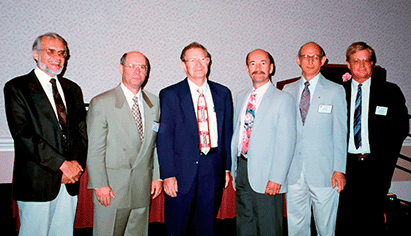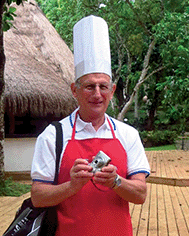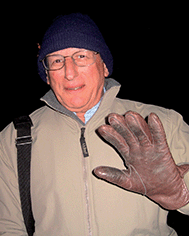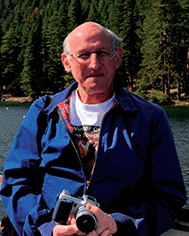Community Leaders: Ramon M. Barnes
Gary M.
Hieftje
*a and
Joanna
Szpunar
 *b
*b
aDepartment of Chemistry, Indiana University Bloomington, Bloomington, Indiana 47405-7000, USA. E-mail: hieftje@indiana.edu
bCNRS EP 132, Helioparc, 2 Av Pierre Angot, Pau, 64053, France. E-mail: joanna.szpunar@univ-pau.fr
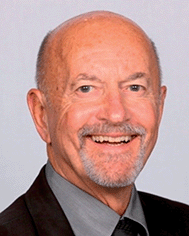 Gary M. Hieftje |
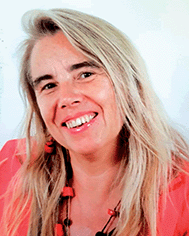 Joanna Szpunar |
This special virtual issue of the Journal of Analytical Atomic Spectrometry is dedicated to Prof. Ramon M. Barnes: educator, scientist, publisher, editor, innovator, conference organizer, and spectrochemist, among others. It is not by chance that “educator” is listed first among these pursuits; indeed, many of the others fall under this rubric. “Classroom teacher” springs immediately to mind, but Prof. Barnes is known also for the laboratory-based training of undergraduate students, graduates, postdoctoral associates, and the many scientists who have visited and worked with him. Even broader and of deeper impact has been his organization of highly successful conferences, in which attendees teach each other in pathbreaking methods, concepts, and instrumentation, in which a wide range of short courses are offered that address both basic and advanced techniques in plasma spectrometry, and in which junior and established scientists have the opportunity to interact informally in an atmosphere that fosters free exchange of new ideas and findings. Lastly, his publication of the ICP Information Newsletter, now in its 47th year, has served to inform the community of spectrochemists about recent events, concepts, and activities in their field.
One of us (GMH) has known Prof. Barnes for more than 56 years, having learned the intricacies of DC arc and high-voltage spark spectrometry under his tutelage as a graduate-level teaching assistant, and having benefited from his expertise in designing an “ideal spark source” and time-resolved spectrograph as a first graduate research project. We have also witnessed how generous he is with his knowledge, time and resources in fostering the development of younger scientists and in ensuring that true diversity can be maintained at science gatherings in which he has played a part.
The other one of us (JS) has enjoyed interactions with Prof. Barnes for only(!) 30 years. The first encounter, at the Winter Plasma Conference in San Diego in 1992 at which she participated as an awed PhD student, was just the beginning of yearly meetings, at US, European and Asia-Pacific Plasma Winter Conferences, and many other meetings. Prof. Barnes’ gift to attract, encourage and support scientists from Europe, and not only the young ones, has created a world-wide community of plasma spectrochemists. It was contagious to a point of encouraging JS to chair the 2013 European Winter Conference in Cracow, Poland, and to co-organize the 2019 one in Pau, France.
Prof. Barnes received his B.S. degree from Oregon State University in Corvallis, OR, in 1962 and a Master of Arts degree from Columbia University (New York) a year later. Only three years after that, in 1966, he was awarded a PhD from the University of Illinois under the direction of Prof. Howard V. Malmstadt. This timeline is all the more impressive in view of the fact that all of Prof. Malmstadt’s graduate students were assigned teaching duties, not only during the Spring and Autumn semesters but also in the Summer, as part of the renowned Malmstadt short course on “Electronics for Scientists”. During the Fall semester, Prof. Barnes was given responsibility for the segment on “Emission Spectrometry” in Malmstadt’s course on spectrochemical analysis. In it, graduate students were required to become at least somewhat proficient with DC arc and HV spark emission sources, with both photoelectric and photographic readout systems, and with grating-based dispersion devices. Prof. Barnes ran a tight ship, expecting graduate students under his direction to work diligently, and to maintain a spotlessly clean laboratory. All of us following this regimen slept little during these sessions, but none so little as Prof. Barnes himself.
Prof. Barne’s dissertation research was on the subject of time-resolved spark spectroscopy and involved the taming, care, and feeding of a complex instrument that combined a stabilized, triggered spark source and a time-resolved photographic spectrograph. Time resolution was obtained by means of a rotating mirror that swept the image of the spark downward along the entrance slit of the spectrograph. As a result, the vertical axis of the photographic plate registered time, with sub-microsecond resolution, while a broad emission spectrum appeared on the horizontal axis. Because adequate signal-to-noise ratios could be achieved only by integrating the emission spectra of many sparks, it was necessary to repetitively trigger the spark source at a reproducible point during the rotation cycle of the mirror. Needless to say, these investigations were complex but highly successful, and resulted in a dissertation entitled “Quantitative Analysis of Solutions and Solids and the Identification of Ionization Levels by Submicrosecond Time-Resolved Spark Emission Spectroscopy”.
Following graduate school, the newly minted Dr Barnes fulfilled his ROTC military obligation with a post to the NASA Lewis Research Center in Cleveland, OH. During this period (1966–68) he again pursued research in emission spectrometry, some of which led to a 1969 NASA publication “Preliminary Development of Spectrochemical Analysis of Superalloys with the Liquid-Layer Solid-Sample Spark Technique”. This document is still available from Amazon but carries a price tag of $902.81!! However, interested parties should respond immediately; Amazon reports that only a single issue remains available (see https://www.amazon.com/s?i=stripbooks%26rh=p_27%3ARamon+M.+Barnes%26s=relevancerank%26text=Ramon+M.+Barnes%26ref=dp_byline_sr_book_1) “(Note added in proof: since preparation of this Editorial, it appears that this rare item has now been purchased and is no longer available)”.
Upon leaving the NASA-Lewis center, Prof. Barnes accepted a one-year (1968–69) postdoctoral position at the Ames Laboratory of Iowa State University, under the direction of Prof. Velmer Fassel, a name justifiably famous throughout our community. Afterward, he was appointed as an assistant professor at the University of Massachusetts. At UMASS, he rapidly rose through the professorial ranks and retired in 2000 in the rank of professor. Upon retirement, Barnes was honored with an emeritus position, which he holds to the present day.
Along the way, Prof. Barnes was active in a number of additional ways that have been of tremendous importance to the atomic spectrometry community. In June 1975, he published the inaugural issue of the ICP Information Newsletter, now in its 47th year. He also founded the University Research Institute for Analytical Chemistry (URIAC) in Amherst MA and, in 1980, the ongoing biennial series of Winter Conferences on Plasma Spectrochemistry (hereafter “Winter Conference”).
The Winter Conferences have been of sufficient importance to justify additional coverage here. The earliest such conferences were organized by Leo de Galan of the University of Delft, and were held in Noordwijk, Netherlands in 1976 and 1978. The baton was then passed to Prof. Barnes who held his first Winter Conference in 1980, in Puerto Rico. Winter Conferences have been held in the USA every two years since, with the most recent being in Tucson, AZ, in 2022. The most recent conference for which figures are available drew more than 500 participants from about 30 countries, featured 300 presentations (including six plenary and five heritage lectures and 34 invited presentations), more than 50 short courses, five workshops and around 50 exhibitors. Because of the success of these gatherings, others have sprung up, beginning in Leysin, Switzerland in 1985 and organized by Jean-Michel Mermet. As with the USA meetings, the European Winter Conferences have been biennial, alternating with those in the US. Similarly, Asia-Pacific Winter Plasma Conferences have been held every two years, ordinarily in the same year as the European gatherings. The first, in 2005, was in Chiang Mai, Thailand, and organized locally by Atitaya Siripinyanond, but with a great deal of organizational assistance from Prof. Barnes. Proceedings of the three regional Winter Conferences have been published in the most prestigious journals in analytical chemistry and atomic spectrometry. More information on the series of Winter Conferences can be obtained from the web [https://icpinformation.org/winter-conference].
Prof. Barne’s own research has resulted in over 300 journal publications and four books. His work has spanned a broad range of areas, including high-voltage spark emission spectrometry, ICP fundamentals, the invention of a sealed ICP system that requires virtually no gas flow, the coupling of separation systems (e.g. field-flow fractionation, capillary electrophoresis) with ICP spectrometry, the study, characterization, and development of systems for speciation and metallomics, novel techniques for sample preparation, boron determination, applications of ICP-AES and ICP-MS, and many others.
These achievements have been recognized by the scientific community in several ways. Prof. Barnes appropriately received the inaugural Winter Conference Award sponsored by Thermo Fisher Scientific in 2010 and the prestigious Colloquium Spectroscopicum Internationale (CSI) award in 2013. Special symposia in his honor have been arranged at many national and international conferences, he was featured in a recent “Sitting down with…” interview in The Analytical Scientist (see The Analytical Scientist, issue 99, Aug./Sept. 2021, pp. 50–51), and a special book to commemorate his 80th birthday was commissioned and featured congratulations and deep expressions of gratitude from his many colleagues, friends, and students. There has even been a variety of daylily flower named after Ramon Barnes, in recognition of his many achievements (see https://www.dynamicdaylilies.com/DrRamonBarnes.html). [Thanks to Dmitry Bandura for alerting us to this last accolade.]
As testimony to the widespread, indeed international impact of Prof. Barnes, we reproduce here a sampling of accolades from many who learned of this planned special issue. We regret that space does not permit including remarks in their entirety or even inclusion of comments from all who wrote.
From Alfredo Sanz-Medel (Spain): “I couldn’t think of a more well-deserved honoring to Ray’s ending of his long, devoted and fruitful work to develop, to boost and spread analytical plasma spectrochemistry, virtually from its beginnings. Along the years, Ray has been there as a sort of “backbone” of all plasma research for analytical purposes worldwide.”
From Detlef Günther (Switzerland): “Ramon Barnes has – with the organization of the Plasma Winter Conference – supported and formed generations of analytical scientists over more than 40 years. Most invited and plenary lectures are given today by people who started their career at this conference. All of us got introduced to an exciting network and were able to discuss our first results with colleagues. This mentorship is most valuable and I am grateful that I have been part of it.”
From José Broekaert (Belgium) (concerning the inaugural 1980 Winter Conference in Puerto Rico): “Many research ideas emerged from the discussions with the pioneers of ICP spectroscopy including the manufacturers in a most friendly atmosphere. It is with enthusiasm and thanks that I think back of so many nice meetings organized by Ramon Barnes at the frontier developments of our research discipline.”
From Atitaya Siripinyanond (Thailand) (Prof. Barne’s 10th PhD graduate): “Apart from his many contributions to atomic spectrometry, Prof. Ramon Barnes has also played a role in many hyphenated techniques with plasma spectrometric detection. Back in my time as a graduate student at UMASS Amherst during 1997–2002, he introduced me to the research area of field-flow fractionation-ICP-MS, which later on has become very popular in the study of nanoparticles in various matrices.”
From Lu Yang (Canada): “I met Ramon at my first winter conference (my first conference too) in 1998 as a very young scientist, being greeted by him in person at the door of the hotel, instantly made me feel welcome and very warm (remember I was from −20 °C Ottawa, Canada). I admire his great personality and his achievements in the spectroscopy field. He has already left a legacy for me and young generations to follow.”
From Patricia Smichowski (Argentina): “Ramon is for me, above all things, a great friend and a great person. Ramon is an example to be followed. He is a tireless traveler and has spread science around the world. Thank you for your help every time we have asked and for being a great scientist who has already left a legacy for future generations.”
From Marco Aurélio Zezzi Arruda (Brazil): “A life devoted to science, combined with his competence, allowed the outstanding achievements of our friend, Prof. Ramon Barnes. The activities of Ramon spread around the world… In addition to being an outstanding researcher, Ramon is a fantastic human being, and he will always be an example to be followed.
From Jose Luis Gomez Ariza (Spain): “Perhaps the most important quality of (Ramon) was always humanity. Those of us who have known and dealt with him for many years have always felt his support and of course his enormous desire for the advancement and consolidation of atomic spectroscopy. Ramon has been a great scientist, but at the same time a great promoter of many other scientists and of our discipline.”
And finally, a clever poem from Diane Beauchemin (Canada) that summarizes the feelings of many:
Remember him for starting the Winter Conference?
All of us sure do, with everlasting gratitude!
Many gather from around the world with confidence:
One cannot miss a chance to talk to the multitude,
Nor a chance to meet people with immense experience.
Because of him, the plasma users community,
Along with vendors, reunite as a family,
Rekindling bonds and making new ones year after year.
Numerous collaborations started without fear,
Every so often yielding papers, and friends so dear.
Simply amazing has been his generosity!
On behalf of the editors of the Journal of Analytical Atomic Spectrometry (particularly Becky Brodie), the Royal Society of Chemistry, the authors who contributed to this special virtual issue, and all who practice the sciences of spectrochemistry and atomic spectrometry, we are pleased to dedicate this issue to Prof. Ramon Barnes and to thank him for his ongoing contributions to our science and community. A few photos of Prof. Barnes, showing his worldwide impact, are given below (Fig. 1–7).
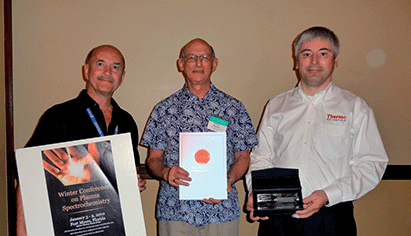 | ||
| Fig. 2 Ramon receiving the inaugural Winter Conference Award, Sanibel, FL, 2010. From left: Gary Hieftje, Ramon Barnes, Lothar Rottmann (Thermo Scientific representative). | ||
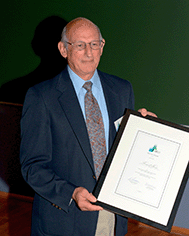 | ||
| Fig. 3 Ramon Barnes receiving the Colloquium Spectroscopicum Internationale Award, Tromso, Norway, 2013. | ||
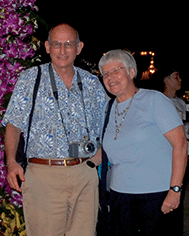 | ||
| Fig. 7 Ramon and Dorothy Barnes at the Asia-Pacific Winter Conference dinner, Bangkok, Thailand, 2006. | ||
| This journal is © The Royal Society of Chemistry 2022 |

